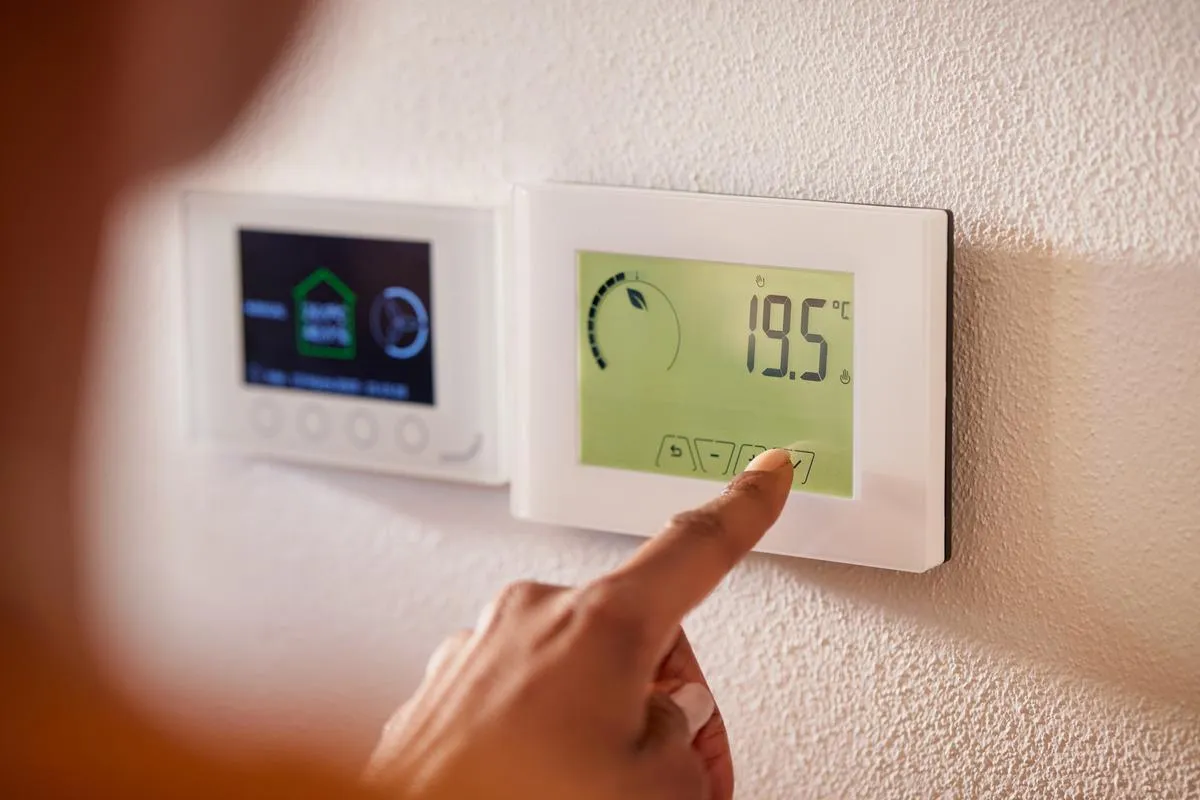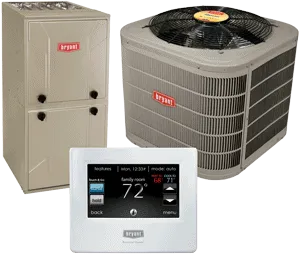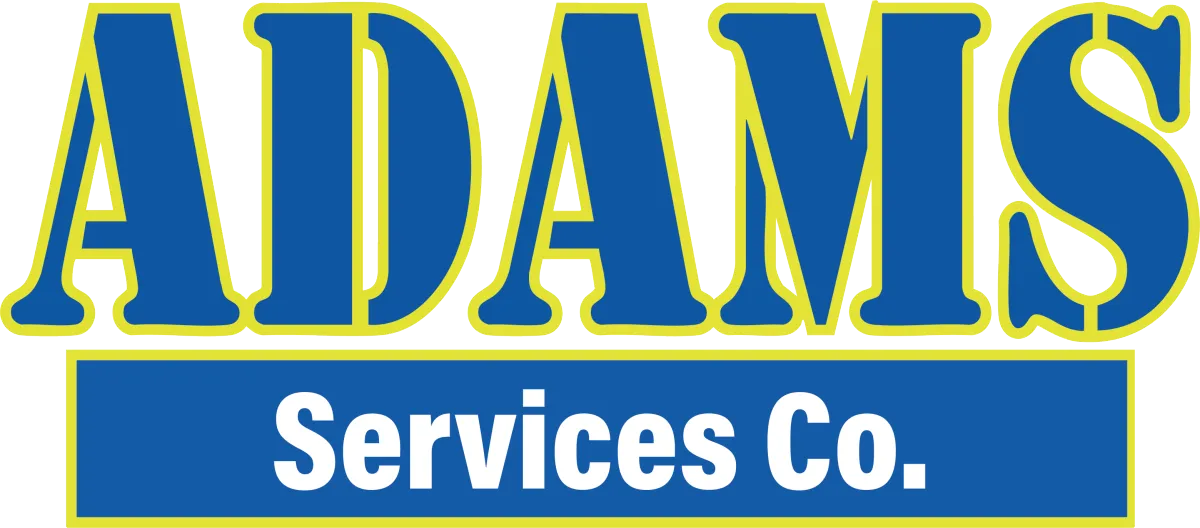Adams Heating & Cooling
HVAC Experts You Can Trust
Serving Tuscaloosa, AL, Birmingham, AL, and surrounding areas since 1982

The Role of Thermostats in HVAC Performance
Thermostats are essential devices in heating, ventilation, and air conditioning (HVAC) systems. They act as the control center, regulating the temperature in your home or business. A thermostat senses the current temperature and compares it to your desired setting. When there’s a difference, it signals your heating or cooling system to turn on or off, maintaining a comfortable environment. The importance of a thermostat in heating system performance cannot be overstated—it directly affects how efficiently your system operates and how comfortable you feel indoors.
Types of Thermostats
Mechanical Thermostats
Mechanical thermostats are the traditional type that many homeowners are familiar with. They have been around for decades and work using simple mechanical components. Typically, these devices utilize a metal bimetallic strip or a mercury switch to detect temperature changes. When the temperature rises or falls, the bimetallic strip bends or the mercury moves, which triggers the HVAC system to turn on or off.
How They Work:
Bimetallic Strip: This strip is made of two different metals bonded together. As the temperature changes, the metals expand or contract at different rates, causing the strip to bend. This bending activates the HVAC system when a certain temperature is reached.
Mercury Switch: In older models, a glass tube filled with mercury is used. When the temperature changes, the mercury moves to either close or open an electrical circuit, activating the heating or cooling system.
Pros:
Generally More Affordable: Mechanical thermostats are often less expensive upfront compared to digital options, making them accessible for many homeowners.
Simple to Operate: With basic settings and no complex menus, mechanical thermostats are easy to understand and operate. This can be a significant advantage for those who prefer straightforward technology.
Cons:
Less Accurate: Mechanical thermostats can be less precise than modern digital or smart thermostats. They may not maintain the desired temperature as effectively, leading to discomfort.
No Programming Features: Unlike digital models, mechanical thermostats do not offer scheduling capabilities. This can result in energy waste, as they often run continuously, even when no one is home.
Digital/Programmable Thermostats
Digital or programmable thermostats have taken temperature control to the next level, making them a popular choice among modern homeowners. These devices allow users to set specific schedules for heating and cooling, meaning you can have different temperature settings at different times of the day.
Key Features:
Scheduling: One of the standout features of programmable thermostats is their ability to create a customized heating and cooling schedule. For example, you can set your thermostat to lower the temperature at night when you’re sleeping and raise it just before you wake up. This feature helps reduce energy consumption during times when heating or cooling isn’t needed.
Temperature Control: Digital thermostats provide more precise temperature settings than their mechanical counterparts. Many models allow you to adjust the temperature in smaller increments, ensuring a comfortable environment without overworking your HVAC system.
Benefits:
Increased Energy Efficiency: By reducing usage when you’re not home or during the night, programmable thermostats can significantly lower your energy bills. Studies show that setting back the thermostat by just a few degrees can lead to substantial savings over time.
Enhanced Comfort: These devices can align the indoor temperature with your daily routine. For example, if you’re away during the day, you can program the thermostat to cool down just before you return, ensuring you walk into a comfortable home.
Digital and programmable thermostats bridge the gap between basic temperature control and modern smart technology, making them an excellent investment for energy-conscious homeowners.
The Role of Thermostats in Energy Efficiency
Temperature Regulation
Thermostats play a vital role in maintaining the right temperature in your space, which is essential for both comfort and energy efficiency. A well-functioning thermostat ensures that your home stays at the desired temperature without unnecessary energy expenditure.
How They Maintain Temperature:
Cycling the HVAC System: Thermostats constantly monitor the indoor temperature. When the temperature deviates from your set point, the thermostat signals the HVAC system to turn on or off. This cycling process allows the system to maintain a consistent indoor climate. By only running the system when needed, thermostats prevent energy waste, which can occur if the HVAC runs continuously.
Preventing Overworking: If your thermostat is properly calibrated and functioning well, it will prevent the HVAC system from overworking. This not only saves energy but also extends the lifespan of your heating and cooling units. By avoiding unnecessary strain on your system, you can reduce maintenance costs and improve overall efficiency.
Thermostat Impact on Energy Bills
The settings on your thermostat can significantly influence your monthly energy bills. Making small adjustments can lead to noticeable savings over time, impacting your budget positively.
Correlation with Energy Bills:
Higher Summer Settings: Setting your thermostat to a lower temperature during the hot summer months can lead to increased energy consumption. Many homeowners instinctively crank up the air conditioning to combat the heat. However, this can cause bills to spike dramatically. Every degree lower can increase energy costs by approximately 3-5%.
Lower Winter Settings: Similarly, during the winter, setting the thermostat too high can also result in high energy bills. Keeping the thermostat at a comfortable but not excessive temperature can lead to considerable savings. For example, lowering the temperature by just a couple of degrees can reduce heating costs significantly.
Tips for Adjusting Settings:
Set Back for Savings: Consider setting your thermostat a few degrees lower in winter and a few degrees higher in summer when you’re asleep or away. This practice, known as temperature setback, can help reduce your energy consumption without sacrificing comfort. Many programmable and smart thermostats can automate this process, adjusting the temperature based on your schedule.
Use a Fan: In summer, consider using ceiling fans to circulate air. You can set your thermostat a few degrees higher and still feel comfortable. A fan can help distribute cool air evenly throughout the room, reducing the need for the AC to run constantly.
Monitor and Adjust: Take the time to monitor your energy bills over a few months after making changes. Adjust your thermostat settings based on seasonal changes and your family's schedule. Remember, every degree counts!
The thermostat is a critical component of your HVAC system that directly influences energy efficiency and cost savings. By understanding how to use it effectively, you can maintain a comfortable home while keeping energy bills in check.
Practical Tips to Avoid Common Mistakes
Common Thermostat Mistakes
Many homeowners make mistakes that can lead to higher energy costs and discomfort. Understanding these common pitfalls can help you optimize your HVAC system and save money.
Not Utilizing Scheduling Features
One of the biggest mistakes is not taking full advantage of scheduling features available in modern thermostats, particularly programmable and smart models.
Consequences:
Continuous Operation: When you don’t set a schedule, your heating or cooling system may run continuously throughout the day and night. This leads to significant energy waste, as the system works harder to maintain a constant temperature, even when no one is home or when everyone is sleeping.
Higher Energy Bills: Without scheduling, you could be paying for energy you don’t even need. Running the HVAC system at full capacity during the hours when it’s unoccupied can inflate your monthly bills unnecessarily.
Solution:
Take the Time to Program: Spend a little time to program your thermostat according to your daily routine. Set it to lower or raise the temperature during times when the house is empty. Most smart thermostats can learn your habits over time, adjusting automatically for you, but it’s still beneficial to input your typical schedule.
Utilize Smart Features: If you have a smart thermostat, use its app to adjust settings remotely or set it to adapt to changes in your routine. Many models allow for geofencing, where the thermostat adjusts itself based on your proximity to home.
Incorrect Placement of the Thermostat
Another common mistake is the improper installation of the thermostat itself. The location of your thermostat can greatly influence its performance.
Consequences:
Inaccurate Readings: Installing the thermostat near windows, doors, or heat sources like lamps or radiators can lead to misleading temperature readings. For example, a thermostat located near a sunny window might sense a warmer temperature and trigger the air conditioning unnecessarily, while one near a drafty door could read colder and keep the heating system running longer than needed.
Inefficient Heating and Cooling: Incorrect placement can cause your HVAC system to cycle on and off more frequently than necessary, leading to uncomfortable temperature fluctuations and increased wear and tear on the system.
Solution:
Optimal Placement: Ideally, place your thermostat in a central location, away from direct sunlight, drafts, or heat sources. It should be on an interior wall where it can accurately gauge the average temperature of your home.
Consult a Professional: If you’re unsure about the best location for your thermostat, consider consulting an HVAC professional. They can assess your home and provide recommendations to ensure optimal placement for accurate readings.
Solutions and Resources
To help manage energy costs effectively and avoid common thermostat mistakes, consider the following solutions:
Budgeting Apps
Using budgeting apps can be a game-changer for tracking your energy use and expenses.
Benefits:
Monitor Energy Consumption: Many apps allow you to input your energy costs and track usage over time. This visibility can help you identify patterns in your energy consumption and see the impact of your thermostat settings.
Set Financial Goals: Budgeting apps can help you establish savings goals for your energy expenses. By visualizing your spending, you can motivate yourself to make changes that lead to lower energy bills.
Recommended Apps:
Look for apps specifically designed for household budgeting or energy management. Some utility companies even offer their own apps to help customers monitor their energy use.
Consulting Financial Advisors
For tailored advice on energy management, speaking with financial advisors can provide valuable insights.
Benefits:
Personalized Recommendations: Financial advisors who specialize in energy efficiency can help you assess your current energy use and suggest strategies for saving money. They can offer insights based on your specific household needs and financial situation.
Long-term Planning: Advisors can help you understand how energy efficiency investments, like upgrading to a smart thermostat, can lead to long-term savings. They may also provide guidance on budgeting for HVAC maintenance or replacement.
How to Find Advisors:
Look for local or online energy management consultants, or ask for referrals from friends or family. Research their credentials and reviews to ensure they’re reputable.
By avoiding these common thermostat mistakes and utilizing available resources, you can significantly improve your home’s energy efficiency, enhance comfort, and save money on energy bills.
Ideal Temperature Settings
Comfort and Efficiency
Finding the right temperature settings in your home is crucial for achieving both comfort and energy savings. The temperature you choose can greatly impact your overall comfort level, especially during extreme weather conditions. However, it’s important to balance comfort with energy efficiency to keep your utility bills manageable. The right settings not only create a pleasant living environment but also help you conserve energy, contributing to both your budget and the environment.
Recommended Settings: For winter, a commonly recommended setting is around 68°F during the day. This temperature is generally comfortable for most people while allowing your heating system to run efficiently. At night, consider lowering the thermostat to around 60-65°F. This small adjustment can significantly reduce energy consumption, as you often use extra blankets or comforters while sleeping. In the summer, a comfortable indoor temperature is typically around 78°F when you’re at home. When you’re away, raising the temperature by a few degrees can lead to substantial energy savings. Every degree you increase can lead to a 3-5% reduction in cooling costs, making a noticeable difference in your energy bills.
Benefits of Lower Settings: Utilizing lower settings during non-peak hours can provide significant savings over time. For instance, if you consistently lower your thermostat at night or when you leave the house, you may find that your monthly energy expenses decrease dramatically. Many homeowners underestimate the cumulative effect of these small adjustments. By proactively managing your thermostat settings, you not only enhance your comfort but also reduce the workload on your HVAC system, which can extend its lifespan and reduce maintenance needs.
Adjusting for Seasonal Changes
As the seasons change, so should your thermostat settings. It’s essential to be mindful of how external temperatures affect your indoor climate and adjust accordingly. Making seasonal adjustments can help maintain a consistent level of comfort while optimizing energy use throughout the year.
Modify as Needed: Regularly assessing and adjusting your thermostat settings is a simple yet effective way to enhance efficiency. As the weather warms up in spring and summer, you may need to lower your thermostat settings to counteract the heat outside. Conversely, as temperatures drop in the fall and winter, you’ll want to increase the heat to stay comfortable. Many modern thermostats, especially programmable and smart models, allow you to set these adjustments in advance, so you don’t have to think about it daily. By establishing a seasonal routine for adjusting your thermostat, you can ensure that your home remains comfortable without sacrificing energy efficiency.
Finding and maintaining ideal temperature settings can significantly impact your comfort and energy savings. By being mindful of recommended settings and making regular adjustments according to the season, you can create an efficient and pleasant living environment.
Importance of Regular Maintenance
Calibration and Maintenance
Regular maintenance is crucial for ensuring that your thermostat functions accurately and efficiently. Just like any other component of your HVAC system, thermostats require periodic attention to maintain their performance. Over time, dust accumulation, battery depletion, and environmental factors can affect how well your thermostat operates. Neglecting these aspects can lead to inaccurate readings and inefficient temperature control, ultimately impacting your comfort and energy bills.
Ensuring Accurate Readings: One of the key aspects of thermostat maintenance is ensuring accurate readings. To achieve this, it’s important to check that your thermostat is installed correctly. Make sure it is level and securely mounted on the wall. If the thermostat is tilted or improperly positioned, it can lead to skewed temperature readings. Additionally, placing the thermostat in a location that is exposed to direct sunlight or near heat sources, such as lamps or appliances, can cause it to register incorrect temperatures. This misrepresentation can lead to your HVAC system working harder than necessary, either heating or cooling more than needed, which can increase energy consumption and costs.
Tips for Maintenance: To keep your thermostat in optimal working condition, there are several simple maintenance tasks you can perform. One of the easiest and most important is to replace the batteries annually, especially for battery-operated models. Even if the batteries seem to be functioning, old batteries can lead to sporadic performance issues, so a yearly replacement is a good practice.
Another crucial maintenance tip is to clean the thermostat itself. Dust and debris can accumulate inside the unit, potentially interfering with its operation. Gently wiping the exterior with a damp cloth can help maintain its condition. For programmable and smart thermostats, make sure to update any software or firmware to benefit from the latest features and improvements.
Finally, consider scheduling a professional HVAC maintenance check-up at least once a year. A qualified technician can thoroughly inspect and calibrate your thermostat, ensuring it is functioning at its best. They can also check the entire HVAC system, which can further enhance efficiency and prolong the life of your equipment.
Common Problems and Solutions
Even with regular maintenance, thermostats can encounter issues that affect their performance. Recognizing these problems early and understanding how to address them is essential for maintaining an efficient HVAC system.
Inaccurate Readings: One common issue is inaccurate temperature readings. If your thermostat displays a temperature that differs significantly from the actual room temperature, recalibration may be necessary. This process usually involves following the manufacturer’s instructions to reset the thermostat’s sensors. If recalibration doesn’t resolve the issue, it could indicate a deeper problem, such as wiring issues or a malfunctioning sensor, which may require professional attention.
Connectivity Issues: For smart thermostats, connectivity problems can disrupt remote access, which can be frustrating. If your smart thermostat fails to connect to Wi-Fi, it may limit your ability to adjust settings or monitor energy usage while you’re away from home. To troubleshoot, first ensure that your Wi-Fi router is functioning correctly and is within range of the thermostat. Sometimes, simply resetting the thermostat or the router can resolve connectivity issues. If problems persist, consult the user manual or the manufacturer’s customer support for guidance.
Conclusion
In summary, thermostats play a pivotal role in enhancing HVAC performance and improving overall energy efficiency in your home. They are not just simple devices that control temperature; they are the brain of your heating and cooling system, ensuring that your living space remains comfortable while minimizing energy waste. By gaining a deeper understanding of how thermostats work, as well as recognizing and avoiding common mistakes, you can significantly optimize your HVAC system. This optimization leads to a more comfortable environment and helps you achieve lower energy bills—something every homeowner can appreciate.
Moreover, if you find that your current thermostat is outdated or lacking in features, consider an upgrade to a modern model. Today’s smart and programmable thermostats come packed with advanced capabilities, such as remote access, learning algorithms, and energy usage monitoring. These features not only enhance your control over your home’s climate but also offer significant potential for cost savings over time. Investing in a smart thermostat could lead to better energy management, allowing you to adjust settings based on your lifestyle and preferences.
For those who want to explore their options further or seek assistance in selecting and installing the right thermostat for their needs, don’t hesitate to reach out. At Adams Heating and Cooling, we’re dedicated to helping you achieve the perfect temperature in your home. Our experienced team is ready to provide you with tailored solutions and expert advice to ensure that your HVAC system runs efficiently and effectively.
If you have any questions or would like more information about upgrading your thermostat or improving your HVAC system's performance, call Adams Heating and Cooling at 205-339-6540. We’re here to help you create a comfortable and energy-efficient living space that meets your needs.

Tired of seeing those sky-high electric bills?
It's time to take control of your energy costs, and your HVAC system is a great place to start!
No more sweating over those monthly expenses!
Grab our FREE checklist to discover simple, yet effective, ways to lower your energy consumption and save money on your electric bill.
Inside this handy guide, you'll find:
Easy-to-follow tips to optimize your HVAC system's efficiency.
Common energy-wasting mistakes to avoid.
Actionable steps to make a real difference in your energy usage.

Free Estimates on Complete System Replacement
Call Now 205-339-6540
Office: 3415 Hargrove Road East,
Tuscaloosa, AL 35405
Office: 1236 Blue Ridge Blvd, Suite 111, Hoover, AL 35226
Call 205-339-6540
Call 205-606-4222
Email: [email protected]





